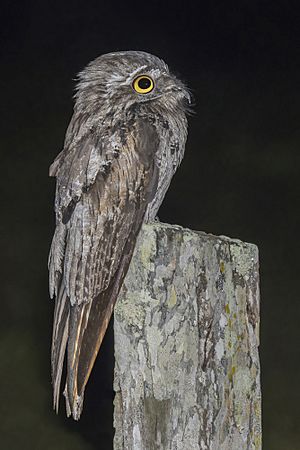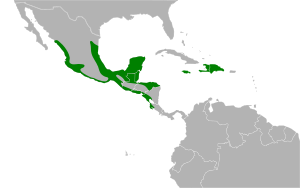Northern potoo facts for kids
Quick facts for kids Northern potoo |
|
|---|---|
 |
|
| Nyctibius jamaicensis mexicanus, Belize | |
| Conservation status | |
| Scientific classification | |
| Genus: |
Nyctibius
|
| Species: |
jamaicensis
|
 |
|
The Northern Potoo (Nyctibius jamaicensis) is a special type of bird that is mostly active at night. It belongs to a bird family called potoos. You can find this bird in places like Mexico, Central America (south to Costa Rica), and on islands such as Jamaica and Hispaniola (which includes the Dominican Republic and Haiti). This bird used to be considered a type of common potoo, but scientists now see it as its own species. This is mainly because of the different sounds it makes.
Contents
About the Northern Potoo
The Northern Potoo was first officially described in 1789 by a German scientist named Johann Friedrich Gmelin. He gave it the scientific name Caprimulgus jamaicensis. Later, in 1816, a French scientist named Louis Jean Pierre Vieillot placed it in the group of birds we now call Nyctibius. The name Nyctibius comes from ancient Greek words meaning "night-feeding." The "jamaicensis" part of its name simply means "from Jamaica," which is where the bird was first studied.
Scientists used to think the Northern Potoo was just a type of common potoo. But since 1995, they've realized it's a separate species. The main reason for this change is that the Northern Potoo makes very different sounds compared to the common potoo.
Types of Northern Potoos
There are five different types, or subspecies, of the Northern Potoo:
- Nyctibius jamaicensis lambi – Found in western Mexico.
- Nyctibius jamaicensis mexicanus – Found from eastern and southern Mexico down to Honduras.
- Nyctibius jamaicensis costaricensis – Found in Costa Rica.
- Nyctibius jamaicensis jamaicensis – This is the original type, found in Jamaica.
- Nyctibius jamaicensis abbotti – Found on Hispaniola and Gonâve Island.
What Does It Look Like?
The Northern Potoo is a fairly large bird, usually about 38 to 46 centimeters (15 to 18 inches) long. It has a long tail and long, pointed wings. Its head is large, but its legs are very short, and its beak is small with a wide opening.
You'll most often see this bird sitting very still and upright on tree branches or posts. Its feathers are grey-brown with a complex pattern of black, grey, and cream colors. This helps it blend in perfectly with tree bark. Its cheeks are light-colored, with a dark stripe below them. The bird has large yellow eyes that can glow red if light shines on them at night.
The sounds the Northern Potoo makes are rough and deep. While the common potoo looks almost the same, its voice is very different. The common potoo makes sad, wailing whistle sounds. The great potoo is even bigger and lighter in color, and it doesn't have the dark stripe on its face.
The Northern Potoo's song is a "rough, squalling kwaaah, kwa-kwa-kwa." It also makes a sudden, strong "rrah!" sound and a barking noise when it's alarmed.
Where It Lives
The five different types of Northern Potoos live across Central America and the Caribbean. They mostly live in low-lying areas. You can find them in woodlands and scrublands that have open spaces. They also live in farmland with scattered trees. Sometimes, you might even spot them near golf courses or in towns. They occasionally visit Puerto Rico, but it's not confirmed if they live in Cuba.
Behavior and Life Cycle
Reproduction
Northern Potoos don't build a fancy nest. Instead, they lay a single egg right on a broken branch. Both the mother and father bird take turns keeping the egg warm. They also both help feed the young bird once it hatches.
Food and Feeding
This bird eats large insects, like moths and beetles. It hunts by sitting on a perch, waiting patiently for prey. When an insect flies by, the potoo quickly flies out to catch it in mid-air.
Status and Conservation
The IUCN (International Union for Conservation of Nature) has listed the Northern Potoo as a species of "Least Concern." This means that it's not currently in danger of disappearing. It lives in a very large area, and there are more than 50,000 adult birds. However, scientists believe that this number might be slowly going down.
Cultural Beliefs
The Mopan people, who live in Central America, have a special belief about the Northern Potoo. They think that if a Northern Potoo (which they call ajsooch’) flies over someone's house many times at night, it means someone in that family might die. To stop this, they chase the birds away using lighted sticks. They believe the glowing parts of the sticks will scare the bird away.
See also
 In Spanish: Nictibio jamaicano para niños
In Spanish: Nictibio jamaicano para niños
Images for kids






